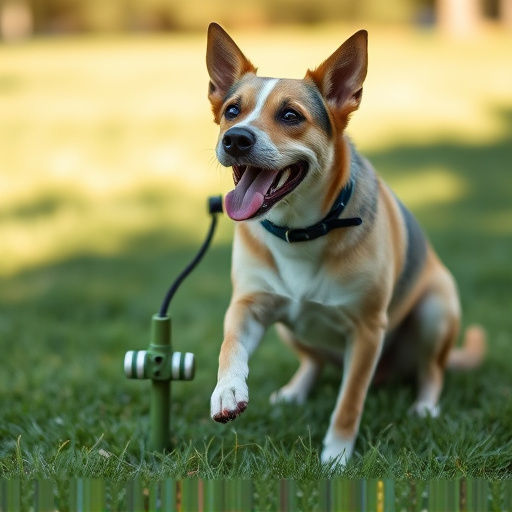Ultrasonic dog repellent devices, effective at keeping dogs away from specific areas, should be strategically placed both indoors and outdoors based on dog behavior and environment. For best results, hang or mount them at eye level or slightly above outdoors, near entry points or loitering areas indoors, and keep them close during walks using clips or attachments. The optimal placement targets frequented areas by unwanted animals while ensuring human comfort and safety away from living spaces and within legal limits. Regular testing and adjustments are crucial for optimal performance.
“Unleash a safe and enjoyable walking experience for you and your canine companion with ultrasonic dog repellents. This comprehensive guide explores how these innovative devices use high-frequency sound waves to deter unwanted pets, ensuring a peaceful stroll. We’ll delve into the science behind their operation and provide strategic placement tips for optimal results. From indoor apartments to outdoor parks, discover the best spots to install these repellers, enhancing your dog’s walking safety without compromising comfort. Plus, learn essential safety considerations before deployment.”
- Understanding Ultrasonic Repellent Devices for Dogs: How They Work
- Best Placement Strategies for Maximizing Effectiveness
- Common Areas to Install Ultrasonic Repellers Indoors and Outdoors
- Safety Considerations: What Users Need to Know Before Deployment
Understanding Ultrasonic Repellent Devices for Dogs: How They Work
Ultrasonic repellent devices are designed to keep dogs away from specific areas using sound waves that humans can’t hear but dogs can. These devices emit high-frequency sounds, typically between 22-25 kHz, which are perceived as unpleasant by canine ears. This technology is effective because it doesn’t harm the dog in any way; instead, it simply triggers an instinctive reaction to avoid the source of the sound.
The best placement for ultrasonic repleaters is strategic and depends on the area you want to protect. For outdoor spaces like gardens or patios, hanging or mounting the devices at eye level or slightly above can be most effective, as dogs often approach from lower levels. Indoors, placing them near entry points, such as doors or windows, or in areas where dogs tend to loiter, will help deter them. Regular testing and adjustments might be necessary to ensure optimal performance based on the dog’s behavior and environment.
Best Placement Strategies for Maximizing Effectiveness
To maximize the effectiveness of ultrasonic dog repellent devices while walking, strategically placing them is key. Positioning the device at your sides or on a belt clip ensures it stays close to you and your pet during walks. This placement allows for continuous emission of the high-frequency sound that repels dogs without obstructing your mobility. Additionally, keeping the device slightly elevated can help target smaller dogs more effectively.
Consider environments where dog interactions are most frequent, such as trails or parks popular among dog owners. Mounting the repellent on a walking stick or attaching it to your clothing using velcro or clips can further enhance its utility. Regular testing and adjustment of the device’s settings based on environmental conditions also ensure optimal performance, ensuring safety during walks remains a priority.
Common Areas to Install Ultrasonic Repellers Indoors and Outdoors
When considering the best placement for ultrasonic repellent devices, both indoors and outdoors, there are several common areas that offer optimal effectiveness. In outdoor settings, placing the repellers near gardens, terraces, or patios can help deter unwanted animals like squirrels, rabbits, and even dogs from intruding into your personal space. The key is to position them at strategic points where these critters are likely to enter, such as under fences or along walls.
Internally, ultrasonic repellents work best in areas frequented by pets or known animal entry points. This could include kitchens, laundry rooms, or basement levels. By placing them here, you create an unpleasant environment for any animals that manage to gain access, encouraging them to look elsewhere for shelter and food. Remember, the devices should be discreetly located to avoid disturbing humans while still achieving their intended purpose.
Safety Considerations: What Users Need to Know Before Deployment
Before deploying an ultrasonic dog repellent, users should familiarize themselves with safety considerations to ensure effective and secure use. These devices emit high-frequency sound waves that are typically inaudible to humans but can deter dogs by causing discomfort. However, it’s crucial to understand that while these repellents are designed to be safe for humans, proper placement is essential to avoid any potential harm. The best placement for ultrasonic repellent devices is outdoors, away from areas where humans frequently gather, such as living spaces or play areas.
Additionally, users should ensure the devices are not within reach of children or pets that might manipulate them. Placement near fences or gates can be effective in deterring dogs from entering certain areas, but it’s vital to check local regulations and guidelines regarding the use of such devices to avoid any legal complications or disturbing neighbors. Regular maintenance and testing of the devices are also recommended to ensure optimal performance and safety.
Ultrasonic dog repellents can effectively manage canine behavior, but ensuring their optimal placement is key to success. By strategically positioning these devices in common problem areas both indoors and outdoors, as outlined in this guide, pet owners can create a safe and welcoming environment for all. Always consider safety factors before deployment, such as ensuring the device operates within safe sound levels for humans and pets. When used responsibly, ultrasonic repeller devices offer a humane and game-changing solution for maintaining a peaceful home and outdoor space for both humans and their four-legged companions.
